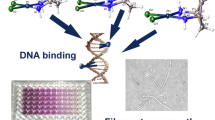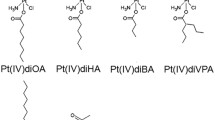Abstract
Acquired drug resistance is a major drawback of using cisplatin in the treatment of cancer; however, analogs containing the 1,2-diaminocyclohexane (DACH) ligand can overcome this resistance. DACH can exist as thetrans-1R,2R, trans-1S,2S orcis isomer, and we have examined whether specific isomers coordinated to a platinum(IV) center can modulate antitumor activities in murine tumor models in vivo. Ten isomeric series of DACH-Pt(IV) complexes were synthesized, each series containing a different combination of axial and equatorial ligands and varying only by the isomeric form of the DACH ligand. Among the ten series, seven clearly indicated superiority of the (R,R)-DACH-Pt(IV) complex against leukemia L1210/0 cells, while in three theR,R andS,S configurations gave similar efficacies which were better than that of the correspondingcis analog. In three out of the ten series, the antitumor activities of theS,S andcis complexes were similar, in six thecis analogs were the least effective, and in the remaining one thecis analog was superior toS,S. One series of complexes with axial chloro ligands and an equatorial 1,1-cyclobutanedicarboxylato group, which had produced the efficacy rankingR,R>cis>S,S in the L1210/0 model, gaveS,S>R,R>cis against cisplatin-resistant L1210/DDP cells,R,R=S,S>cis against B16 melanoma cells, andR,R=S,S=cis against M5076 reticulosarcoma cells. The results demonstrate that profound variation can occur in antitumor activities among isomeric forms of the DACH-Pt(IV) complex. However, the (R,R)-DACH-Pt(IV) complexes appear to be of greater interest overall.
Similar content being viewed by others
Abbreviations
- DACH:
-
1,2-diaminocyclohexane
- CBDCA:
-
1,1-cyclobutane-dicarboxylato
- MTD:
-
maximal tolerated dose
References
Al-Baker S, Siddik ZH, Khokhar AR (1994) Synthesis and characterization of new antitumortrans-R,R-, trans-S,S- andcis-1,2-diaminocyclohexane platinum(IV) complexes. J Coord Chem 31:109–116
Anderson WK, Quagliato DA, Haugwitz RD, Narayanan VL, Wolpert-DeFilippes M (1986) Synthesis, physical properties, and antitumor activity of tetraplatin and related tetrachloroplatinum(IV) stereoisomers of 1,2-diaminocyclohexane. Cancer Treat Rep 70:997–1002
Borch RF (1987) The platinum anti-tumour drugs. In: Powis G, Prough RA (eds) Metabolism and action of anti-cancer drugs. Taylor Francis, London, pp 163–193
Borch RF, Markman M (1989) Biochemical modulation of cisplatin toxicity. Pharmacol Ther 41:371–380
Burchenal JH, Kalaher K, O'Toole T, Chisholm J (1977) Lack of crossresistance between certain platinum coordination compounds in mouse leukemia. Cancer Res 37:3455–3457
Chaney SG, Wyrick S, Till GK (1990) In Vitro biotransformation of tetrachloro(d,l-trans)1,2-diaminocyclohexaneplatinum(IV) (tetraplatin) in rat plasma. Cancer Res 50:4539–4545
Cleare MJ (1983) Structure-activity relationships for anti-tumour platinum complexes. In: Reinhoudt DN, Connors TA, Pinedo HM, Poll KW van de (eds) Structure-activity relationships of anti-tumour agents. Nijhoff, The Hague, pp 59–91
Corbett TH, Valeriote FA (1987) Rodent models in experimental chemotherapy. In: Kallman RF (ed) Rodent tumor models in experimental cancer therapy. Pergamon, New York, pp 233–247
Eastman A (1987) Glutathione-mediated activation of anticancer platinum(IV) complexes. Biochem Pharmacol 36:4177–4178
Eastman A, Schulte N, Scheibani N, Sorenson CM (1988) Mechanisms of resistance to platinum drugs. In: Nicolini M (ed) Platinum and other metal coordination compounds in cancer chemotherapy. Nijhoff, Boston, pp 178–196
Geran RI, Greenberg NH, MacDonald MM, Schumacher AM, Abbott BJ (1972) Protocols for screening chemical agents and natural products against animal tumors and other biological systems (third edition). Cancer Chemother Rep 3:1–103
Gibbons GR, Wyrick S, Chaney SG (1989) Rapid reduction of tetrachloro (D,l-trans)1,2-diaminocyclohexaneplatinum (IV) (tetraplatin) in RPMI 1640 tissue culture medium. Cancer Res 49:1402–1407
Harrap KR (1983) Platinum analogues: criteria for selection. In: Muggia FM (ed) Cancer chemotherapy, vol. 1. Nijhoff, Boston, pp 171–217
Khokhar AR, Xu Q, Siddik ZH (1994) Synthesis, characterization and antitumor activity of amine platinum (II) and (IV) tellurate complexes. J Inorg Biochem 53:297–303
Kidani Y (1991) Preparative development of antitumor 1,2-cyclohexanediamine platinum complexes. Trends Inorg Chem 1:107–125
Kidani Y, Inagaki K, Saito R, Tsukagoshi S (1977) Synthesis and antitumor activities of platinum(II) complexes of 1,2-diaminocyclohexane isomers and their related derivative. J Clin Hematol Oncol 7:197–209
Kidani Y, Inagaki K, Iigo M, Hoshi A, Kuretani K (1978) Antitumor activity of 1,2-diaminocyclohexane-platinum complexes against sarcoma-180 ascites form. J Med Chem 21:1315–1318
Kido Y, Khokhar AR, Siddik ZH (1993) Differential cytotoxicity, uptake, and DNA binding of tetraplatin and analogous isomers in sensitive and resistant cancer cell lines. Anti-cancer drugs 4:251–258
Langdon S, Gescher A, Hickman JA, Stevens MFG (1984) The chemosensitivity of a new experimental model — the M5076 reticulum cell sarcoma. Eur J Cancer Clin Oncol 20:699–705
Ozols RF, Hamilton TC, Reed E, Poirier MC, Masuda H, Lai G, Young RC (1988) High dose cisplatin and drug resistance: clinical and laboratory correlations. In: Nicolini M (ed) Platinum and other metal coordination compounds in cancer chemotherapy. Nijhoff, Boston, pp 197–206
Prestayko AW, Bradner WT, Huftalen JB, Rose WC, Schurig JE, Cleare MJ, Hydes PC, Crooke ST (1979a) Antileukemic (L1210) activity and toxicity ofcis-dichlorodiammineplatinum(II) analogs. Cancer Treat Rep 63:1503–1508
Prestayko AW, D'Aoust JC, Issell BF, Crooke ST (1979b) Cisplatin (cis-diamminedichloroplatinum II). Cancer Treat Rev 6:17–39
Ribaud P, Kelsen DP, Alcock N, Garcia-Giralt E, Dubouch P, Young CC, Muggia FM, Burchenal JH, Mathe G (1980) Preclinical and phase I studies of malonatoplatinum. Recent Results Cancer Res 74:156–162
Rose WC (1986) Evaluation of Platinol analogs using the M5076 murine sarcoma. Anticancer Res 6:557–562
Rose WC, Schurig JE, Huftalen JB, Bradner WT (1982) Antitumor activity and toxicity of cisplatin analogs. Cancer Treat Rep 66:135–146
Rose WC, Crosswell AR, Schurig JE, Casazza AM (1993) Preclinical antitumor activity of orally administered platinum(IV) complexes. Cancer Chemother Pharmacol 32:197–203
Sakata M, Chaney SG, Fangmeier J, Petros WP, Brown T (1993) Pharmacokinetic and biotransformation studies of ormaplatin (NSC 363812) in conjunction with a phase I clinical trial. Proc Am Assoc Cancer Res 34:401
Salem P, Khalyl M, Jabboury K, Hashimi L (1984)cis-Diamminedichloroplatinum (II) by 5-day continuous infusion. Cancer 53:837–848
Siddik ZH, Al-Baker S, Burditt TL, Khokhar AR (1993) Differential antitumor activity and toxicity of isomeric 1,2-diaminocyclohexane platinum (II) complexes. J Cancer Res Clin Oncol 120:12–16
Tutsch KD, Arzoomanian RZ, Alberti D, Feierabend C, Robins HI, Spriggs DR (1992) Phase I trial and pharmacokinetic study of ormaplatin. Proc Am Assoc Cancer Res 33:536
Vollano JF, Al-Baker S, Dabrowiak JC, Schurig JE (1987) Comparative antitumor studies on platinum(II) and platinum(IV) complexes containing 1,2-diaminocyclohexane. J Med Chem 30:716–719
Author information
Authors and Affiliations
Additional information
This work was supported by NIH Grants RO1 CA41581 and RO1 CA50380, and in part by NIH Cancer Center (Core) Support Grant PO30 CA16672
Rights and permissions
About this article
Cite this article
Siddik, Z.H., Al-Baker, S., Thai, G. et al. Antitumor activity of isomeric 1,2-diaminocyclohexane platinum(IV) complexes. J Cancer Res Clin Oncol 120, 409–414 (1994). https://doi.org/10.1007/BF01240140
Received:
Accepted:
Issue Date:
DOI: https://doi.org/10.1007/BF01240140




